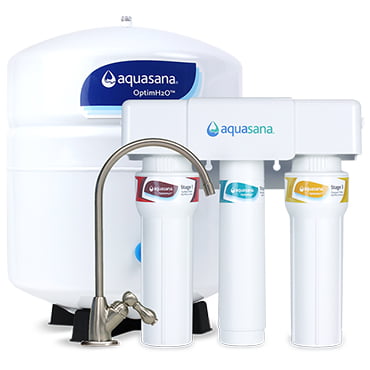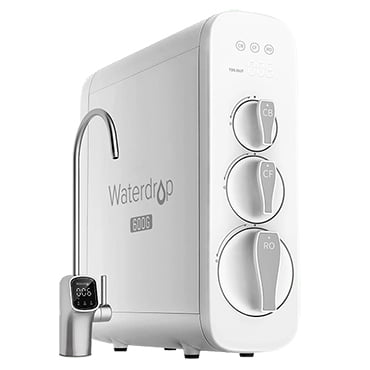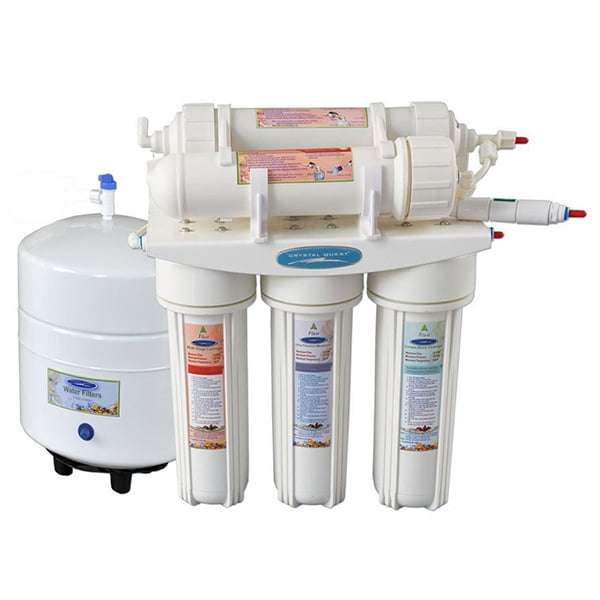How Much Does an Under Sink Reverse Osmosis System Cost?
Written by: Alexandra Uta // Last Updated: Aug 25, 2023
This page may contain affiliate links. If you buy a product or service through such a link we earn a commission at no extra cost to you. Learn more.
Under sink reverse osmosis systems are a popular option for many homes. They’re placed under the sink and filter drinking water without taking up too much space.
If you’re considering getting an under sink reverse osmosis system for your home, we’re here to help you with a cost guide.
In this article, you’ll find out how much under sink reverse osmosis systems cost to purchase, install, and maintain.
Key Takeaways
- The average under sink reverse osmosis system costs between $150 and $600.
- To this, you have to add costs for professional installation ($150 to $400) and yearly maintenance/operation ($60 to $200).
- If you are up for a DIY project, you can also do the installation part yourself and save.
How Much Does an Under Sink Reverse Osmosis System Cost? Prices 2023!
So, how much does an under sink reverse osmosis system cost?
An under sink RO system usually costs between $150 and $600 – a rather large range which is why we’ve prepared a list of different real-life under sink RO system models with their current price tags.
| Under Sink RO System | Price Tag |
|---|---|
| Waterdrop G3 Tankless Under Sink RO System | $499.00 |
| Aquasana OptimH2O Reverse Osmosis System | $349.99 |
| Crystal Quest Thunder 1000C Reverse Osmosis Under Sink Water Filter | $298.40 |
| NU Aqua Platinum Series 5-Stage 100GPD RO System | $179.35 |
| Home Master HydroPerfection (TMHP) Reverse Osmosis Drinking Water Filter System | $529.95 |
| APEC Ultimate Series RO-90 Reverse Osmosis Drinking Water System | $299.95 |
| Brondell H2O+ Circle Reverse Osmosis System | $375.00 |
| Express Water RO5DX Reverse Osmosis Water Filtration System | $148.18 |
| iSpring RCC7AK 6-Stage Reverse Osmosis System | $216.73 |
| Olympia Water Systems OROS-50 5-Stage Reverse Osmosis System | $169.99 |
| Whirlpool WHER25 Under Sink Reverse Osmosis System | $169.00 |
*Last Updated: January 2023
We Recommend: Aquasana OptimH2O
- Our #1 Under Sink Reverse Osmosis System with Storage Tank
- Quite Affordable!
- 5x NSF-Certified
- Remineralizes Water with Healthy Minerals for Better Taste
Factors Affecting Under Sink RO System Cost
Certain factors influence the cost of an under sink reverse osmosis system. These are:
Overall Product Quality
High-quality products are naturally more expensive than low-quality ones. So if you’re going for a high-quality RO system, you’ll have to spend more money.
The Brand
Generally, some brands sell their products at a higher price than others. If you’re buying from a well-known brand with a solid reputation, you’ll probably spend more than if you patronize a newer, less popular brand.
Reality is, sometimes you pay for the brand image alongside the product.
Filtration Process
Some under sink RO systems feature more filtration stages than others. Apart from the RO membrane, there are pre-filters and post-filters. UV light disinfection for killing microbes in the water and remineralization for a more balanced water pH are two good examples here.
NSF Testing/Certification
An NSF certification can assure users that a reverse osmosis system or water filter in general has been tested and confirmed to remove specific contaminants. Some NSF standards also cover material safety among other things.
For under sink reverse osmosis, watch out for NSF standard 58 which measures reduction of many harmful contaminants.
Tank or No Tank
Traditional under sink reverse osmosis systems contain a storage tank to keep the filtered water. However, an RO tank can take up a lot of space which is why you’ll also find tankless under sink RO units.
In general, tank systems are cheaper than tankless systems. Why? Because if you go tankless, you’ll need certain extras – most importantly a water pressure pump.
Additional Features
The reverse osmosis process can be slow and water-wasting. Some under sink RO systems contain an internal pump that increases water pressure to improve the flow rate which also lowers wastewater production significantly.
Some models also include water recycling to reduce wastewater even further.
These additional features increase the price of an under sink reverse osmosis filter, obviously.
Under Sink Reverse Osmosis System Installation Costs
After buying a system, the next thing is to install it. Here, you have two options: either do it yourself or hire a plumber.
DIY vs. Hiring a Plumber
If you’re familiar with plumbing tools and fixing stuff, you can install a reverse osmosis system under your kitchen sink yourself. It takes about two hours to DIY. But if you’re a plumbing rookie, you may need to hire a pro. Professional installation will cost you about $150 to $400.
Maintenance and Operating Expenses
While some people can avoid installation costs, no one can escape care and operating expenses. They are compulsory as long as you want your under sink filter to last. Here’s what you need to know:
New Filter Elements
First, you must replace most pre-filters every 6 to 12 months. That’s because these filters become clogged and less effective after trapping contaminants for some time. If you use large amounts of water containing high levels of pollutants, you’ll need to replace even more frequently.
You must also change the reverse osmosis membrane, every 2 to 5 years.
Lastly, there’s at least one carbon post-filter that needs changing every 1 to 2 years.
All in all, you can expect to spend $60 to $200 yearly on these new filter elements.
Waste Water
Reverse osmosis produces wastewater. And if you use high volumes of water, you’ll also have a large amount of wastewater which may increase your water and sewer bill.
But if your system includes an internal pressure pump, you’ll only waste about 1 gallon of water per 3-5 gallons of filtered water. At that rate, the cost for wastewater become almost negligible.
(Electricity)
Tank-based under sink RO systems may not need electricity to work, but tankless systems do. Fortunately, you probably won’t even notice the additional energy use on your next utility bill.
Total Average Cost (First Year)
| Average Under Sink RO Price Tag | Installation Cost | Yearly Maintenance Cost | Total Average Cost (First Year) |
|---|---|---|---|
| $150-600 | $0-500 | $60-200 | $210-1300 |
Where to Buy an Under Counter Reverse Osmosis System
Online from Brand
Nowadays, most water filter brands have an online store you can buy from. Online shopping directly from a brand gives you discounts and deals that can reduce the purchase price.
However, your only options will be products from that specific brand.
Online from Retailer
An online retailer will have a collection of under sink filters from different manufacturers, and you can also get discounts. But it would be best to do careful research before purchasing, so you don’t buy low quality.
From Local Water Expert
This option may be more expensive than the first two, but it’s worth it. You can approach an expert in your area who will recommend the ideal under sink RO filter after considering your budget and water quality.
From Local Hardware Store
You can also get a wide range of under counter water filters at a store in your locale. However, things may be more expensive here.
Is an Under Sink RO System Worth the Cost?
Reverse osmosis is a very effective process for removing water contaminants. The CDC confirms that reverse osmosis can remove microorganisms and chemical pollutants (even toxic ones like lead) from water.
So if a water test reveals that your water quality is terrible, an RO system is worth the cost. It helps you get rid of the bad stuff and makes your home water safe.
What Is an Under Sink Reverse Osmosis Water Filter and How Does It Work?
An under sink reverse osmosis water filtration system gets installed under a kitchen or bathroom sink. It is a point-of-use system, meaning that it filters only the water that comes from the attached sink.
Here’s how an under sink RO system works:
It has a feed water valve through which water flows to the pre-filters. The sediment pre-filter removes sediment and silt, and the carbon pre-filter removes chemicals like chlorine from the water.
Then, the water flows through the reverse osmosis membrane, removing even the tiniest contaminants. Clean, filtered water enters the system’s storage tank, ready for use whenever you open your kitchen faucet. Before your water flows out of the tap, however, it goes through a post-filter that improves water taste and removes any leftover pollutants.
How to Select the Ideal Under Sink RO Filtration System
Here are things to check before selecting an under sink RO system.
NSF Certifications
An NSF certification is one factor that influences the price of an under sink RO system. As we mentioned earlier, it confirms a system’s performance and quality. So before you choose a product, check if it’s NSF certified.
You should look for NSF standard 58, which confirms that an under sink system can remove lead, arsenic, chromium, TDS, and all kinds of other stuff.
Water Filtration Process
An ideal setup should have 5 or more filter stages. That includes two to three pre-filters (sediment, granular carbon, and carbon block), the primary filter (RO membrane), and a coconut shell post-filter. Only then can you be sure that floating particles, heavy metals, chemicals, microbes, and bad taste/smell are no longer present in your water.
Water Demand
Having an effective under sink filter that does not meet your water demand is no good. You want to be sure that your RO system can provide filtered water whenever you need it. That means that it has to have a big storage tank (for tank systems) or a high flow rate (for tankless systems).
Filter Replacements
It’s best to choose an under sink system with a modular design. Since you replace the entire housing (and not only specific parts), modular filters leave no room for microbes to build up within the system. Modular filters are also easy and quick to replace. But the catch is they cost more than filters with separate housings.
Water Pressure and Wastage
Although you cannot avoid wastewater with RO systems, you can reduce the amount of wasted water. For example, you’ll have minimum wastewater if you use RO systems with a pressure pump. An example of such a water system is the AquaTru.
Long-Term Cost
Another thing to consider is the price and availability of replacement filters. You don’t want to buy a filtration system that you’ll have trouble maintaining later on. Instead, we advise that you go for a system with replacement parts readily available in the market.
Under Sink (Point-of-Use) vs. Whole House Reverse Osmosis Systems
Under sink reverse osmosis systems filter water for a single kitchen sink. Whole house reverse osmosis systems, on the other hand, filter water that flows in the entire house. The former is a point-of-use system (works at the point where you use water), while the latter is a point-of-entry system (works at the point where water enters the home).
If you need filtered water at only a few spots at home, maybe only in the kitchen, you should use an under sink reverse osmosis system. But if you need RO-filtered water at every outlet at home, you’d need whole house RO.
Most homes definitely only require point-of-use RO systems. They can solve all the water problems that whole house RO systems solve, with less space requirements and for a much cheaper price.
If you still need whole house treatment, consider carbon filtration, a water softener, an iron filter, etc.
If you have any thoughts about the question, how much does an under sink reverse osmosis system cost, please don’t hesitate to leave a comment below!
Information provided on BOS is for educational purposes only. The products and services we review may not be right for your individual circumstances.
We adhere to strict editorial guidelines. Rest assured, the opinions expressed have not been provided, reviewed, or otherwise endorsed by our partners – they are unbiased, independent, and the author’s alone. Our licensed experts fact-check all content for accuracy. It is accurate as of the date posted and to the best of our knowledge.






